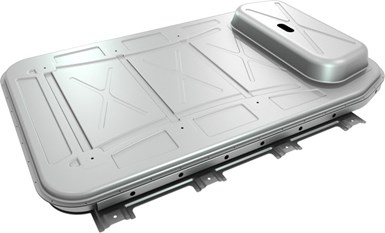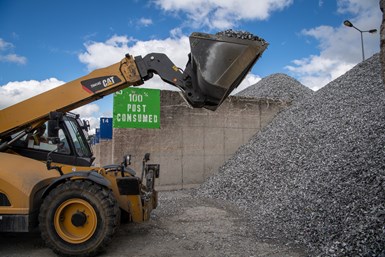Cars, COVID-19 and Climate Change: Driving Sustainability Forward
Life cycle assessments show vehicles designed with lightweight aluminum result in reduced emissions without product sacrifices
#aluminum
The U.S. transportation sector generates nearly 30% of the country’s greenhouse gas emissions–the largest share, globally. It comes as no surprise, when during the height of physical distancing and shelter-in-place orders due to the global coronavirus pandemic beginning this past spring, the world experienced a sharp drop in carbon emissions. With fewer drivers on the road, air pollution declined in major cities across the country. Residents of Los Angeles, once choked by smog, can now view stars in the clear night sky.
As significant as this unintended environmental benefit might be in isolation, it came at a very high societal cost in terms of lost lives, disrupted society and economic turmoil. The future cannot be met through indefinite confinement, nor by eliminating vital transportation options. Instead, it will require aggressive innovation to deliver creative, yet workable solutions.
Although the long-term impact of COVID-19 is not yet known, we do know that there will be a point when traffic increases back to near pre-COVID-19 levels. As the transportation sector eventually gears back up, we should not simply return to pre-COVID-19-level carbon emissions. Making even more sustainable choices must be the guiding light for corporations and individuals alike. For the automotive industry, which has made tremendous strides globally in its effort to reduce environmental impact, sustainability is a fast-rising strategic priority across the entire value-chain. The choices made from the design studio to the dealership will help drive meaningful progress toward a greener tomorrow.
Sustainability Without Sacrifice
The future of the automotive industry revolves around the need for vehicles to be safe, affordable, high performing and highly efficient—no matter the propulsion system or ownership model. As the industry accelerates its commitment to lowering the carbon footprint of its production processes and products, including leadership in the large-scale circular economy, so too are automakers accelerating their shift to multi-material vehicle design. This includes continued moves toward greater aluminum use to help facilitate a new wave of mobility options for American consumers.
The equation is simple: lighter vehicles require less energy (fuel or battery range) to move. Aluminum is the fastest, safest, most environmentally-friendly and cost-effective way to boost fuel economy and cut total carbon emissions.
According to a new survey of North American automakers conducted by DuckerFrontier, total aluminum content is expected to increase by nearly 19% between 2015 and 2022 thanks, in part, to an increase in electrified powertrains and battery electric vehicle platforms. These platforms are expected to use greater amounts of aluminum sheet for closures and aluminum extrusions for structure and battery housing systems to support critically important mass savings priorities.

Aluminum sheet-intensive electric vehicle battery enclosure (Image: Novelis)
In electric vehicles, this mass reduction helps extend battery range, while aluminum battery closures protect from road debris and crashes, delivering robust safety performance. Add to that, several studies from government agencies, automakers and suppliers confirm that aluminum is the most sustainable choice for the environment when compared to both traditional and advanced steels.
In the coming decade, most aluminum platform product forms will more than double in terms of pounds per vehicle and by 2026, net aluminum demand is expected to increase to 514 pounds per vehicle.
These numbers confirm recognition of aluminum’s overall value to the transportation industry and our modern, mobile society.
No Greener Metal for Automotive

Shredded post-consumer aluminum (Image: Hydro Aluminum)
Aluminum is more sustainable today than at any time in history. Data confirms the energy needed to produce primary aluminum is down more than a quarter since 1995 – and its carbon footprint is down nearly 40%. This is equivalent to 37 million barrels of oil saved and 25 million tons of CO2e GHG reduced per year. Aluminum is also infinitely recyclable and the end-of-life recycling rate for automotive aluminum in the United States is above 90%, according to a 2017 report from Worcester Polytechnic Institute’s Center for Resource Recovery.
Automotive aluminum is long been recognized by leading researchers for its significant potential to reduce the environmental impact of automobiles over their full life cycle .
- The U. S. Environmental Protection Agency (U.S. EPA) reviewed dozens of life cycle analyses (LCAs) and confirmed aluminum “as the material most often specified by the LCAs for providing the highest benefits in terms of life cycle energy and GHG reductions.”
- A critically-reviewed study by Lindita Bushi, prominent automotive LCA scientist, found that using advanced aluminum alloys in lightweight pickup truck design produces lower environmental impacts than a steel baseline when the full life cycle is considered.
- Researchers at the U.S. Energy Department’s Oak Ridge National Laboratory studied life cycle carbon emissions, and its peer-reviewed report concluded by noting “ full life cycle environmental analysis confirms that—when compared with both traditional and advanced steels in the areas of cumulative energy demand, potential ozone depletion and other likely factors in climate change—aluminum rises to the top as the best choice for the environment.”
- Ford Motor Company and Magna International Inc. released a life cycle assessment comparing a Fusion to the Mach-I, a prototype lightweight aluminum-intensive sedan that achieved an overall 23% mass reduction and a combined 34 MPG (vs. 28 MPG for the steel-bodied Fusion). This confirmed that by using an aluminum-intensive design, a high-strength steel-bodied car that has reached its maximum fuel efficiency limit can further lower its environmental impact.
Innovations and Fact-Based Assessment
LCA for automobiles is complex and extensive, covering driving technology options, fuel choices, ownership types, material selection and lightweighting effects, and more. The inherit complexity of LCA, coupled with individual practitioners’ freedom and flexibility with inputs when conducting an assessment, can generate misleading or false results – either by mistake or by intent.
Misrepresentation of facts hinders sustainability success. Researchers at the U.S. EPA reviewed dozens of LCA studies and observed that no studies, other than those from the steel industry, claim steel is more sustainable than aluminum overall. EPA concluded, “…assumptions from reports that have divergent results from the majority of the literature [which confirms aluminum’s lower life-cycle carbon footprint] need to be carefully analyzed so that they can inform rather than detract from the larger scientific consensus.”
The U.S. aluminum industry’s trade group, the Aluminum Association, conducted a comprehensive review of studies released by the steel industry to identify major differences between the steel industry and the rest of LCA community. Findings include:
- LCA works from the steel industry considerably underestimate the technical ability of aluminum for mass reduction while overestimating the capability of advanced high strength steel. On average, the mass reduction potential of aluminum is 30-60%, and advanced high-strength steel in the 15-20% range.
- Steel industry data inaccurately portrays mass-induced fuel reduction values (FRV) to favor steel-intensive vehicles rather than lighter, aluminum-intensive vehicles. As one of the most critical inputs in LCA, any small change to FRV has a significant impact on results. Commonly, steel industry FRVs are noticeably lower than what is recommended by leading experts. Because practitioners have choices for use phase energy consumption factor, the Canadian Standard Association Group’s SPE-14040-14 Guideline recommends researchers use values from the 2010 Koffler et al study, “On The Calculation of Fuel Savings Through Lightweight Design In Automotive Life Cycle Assessments,” not the values appearing in steel industry studies.
- Some steel industry LCAs grossly overstate the production stage footprint of aluminum despite current and available source data. Because metals for automotive application can be sourced from production sites around the globe, accurate life cycle inventory (LCI) data must be sensitive to time and geographic location, rather than represent the global average.
- Finally, recycling for post-consumer automotive aluminum in North America exceeds 90%, compared to the steel industry’s lower, mischaracterized, 78.6% for aluminum.
In this era of increasing disinformation, credible data inputs, assumptions and formulas are all-important for data-driven corporate actions and government policies.
Accountability for Sustainability
Credibility is key to maintain momentum in the automotive market. The steel industry’s misinformation, in turn, limits the innovation and progress of the larger transportation industry. The future of transportation and mobility requires accurate information to inform key audiences involved in the business decision-making process for the vehicles of tomorrow.
In an evolving competitive landscape where innovation dominates the race, multi-material vehicle construction will drive the future of automotive design and manufacturing. In a world where each individual vehicle part is examined by engineers to meet the end result need, aluminum, steel, carbon fiber and plastics will continue to all come together in the same vehicle.
The industry’s multi-material approach includes an increased use of aluminum, the second most used – and fastest rising – material in the automotive market, as well as a range of key technologies to meet the need of delivering safe, reliable, and efficient vehicles to consumers. By partnering with the full spectrum of the supply chain, including those in the aluminum industry, automobile manufacturers can deliver on this challenge while also helping enable a greener planet, lower carbon emissions and support overall environmental sustainability for years to come.
_______________
(Marshall) Jinlong Wang is the Senior Environmental/Sustainability Specialist at the Aluminum Association and he holds a master’s degree in environmental management from Yale University. For more information on LCA, visit drivealuminum.org/aluminumnogreenermetal.
RELATED CONTENT
-
Jeeps Modified for Moab
On Easter morning in Moab, Utah, when the population of that exceedingly-hard-to-get-to town in one of the most beautiful settings on Earth has more than doubled, some people won’t be hunting for Easter eggs, but will be trying to get a good look at one of the vehicles six that Jeep has prepared for real-life, fast-feedback from the assembled at the annual Easter Jeep Safari.
-
The Koenigsegg Jesko Has An Amazing Engine
It is hard to believe that this is a vehicle in “serial” production with such extraordinary powertrain performance
-
Multiple Choices for Light, High-Performance Chassis
How carbon fiber is utilized is as different as the vehicles on which it is used. From full carbon tubs to partial panels to welded steel tube sandwich structures, the only limitation is imagination.

